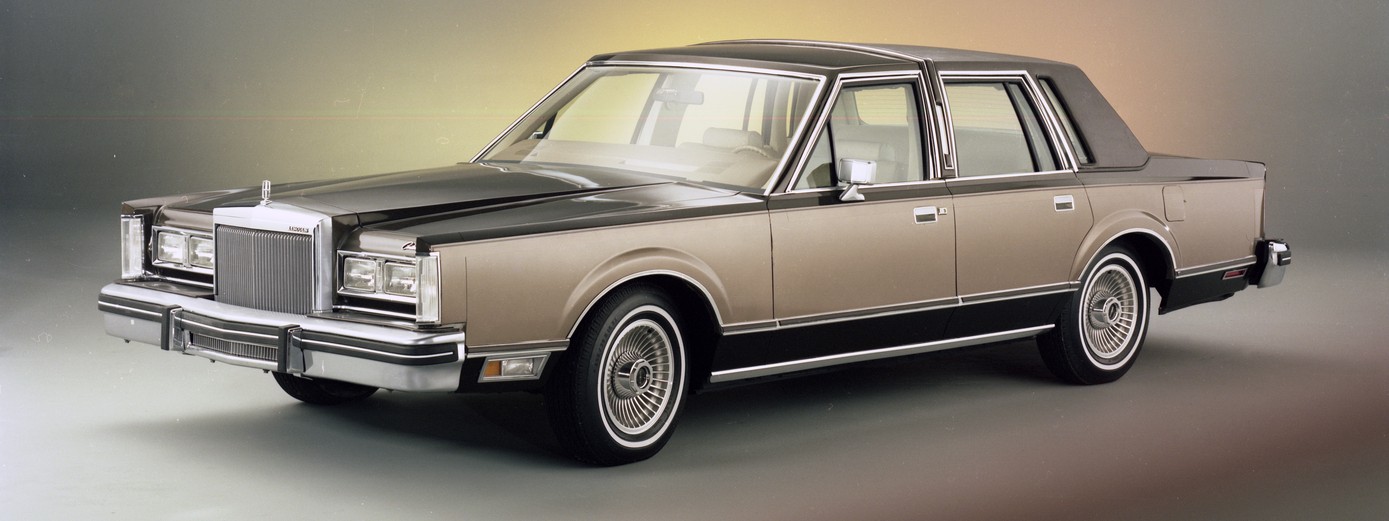
The 1980 Lincoln Continental was the final model of the Sixth generation, with the Town Car becoming a stand-alone model in 1981, the start of the Lincoln Town Car’s first generation.
Everything a Lincoln has always meant. And more.
Since 1921, the name Lincoln has stood for the epitome in prestigious, luxurious, comfortable automobiles. Painstakingly crafted. Elegantly appointed. To usher in the eighties, we are proud to present a Lincoln Continental that is designed and built to honor this heritage. In styling and riding comfort, in interior spaciousness and luxury, it is every inch a Lincoln and every inch contemporary.
To meet the demands of today’s driving, Lincoln’s advanced standard features include EEC, newly refined Electronic Engine Control that incorporates an on-board computer and seven sensors to monitor engine operations. Electronic Fuel Injection for more precise control of fuel usage. And, never before offered in a domestic automobile, an automatic overdrive transmission to maximize operational efficiency.
For 1980, an abundance of electronic options is available. Among these: a remarkable Electronic Instrument Panel with Message Center. Illuminated Entry System. And the Keyless Entry System that lets you open all the doors and the decklid by means of pushbuttons, programmed to respond to your personal five-digit code. As always, Lincoln Continental caters to occupant comfort and driving ease.
Through the efficient utilization of interior space, traditional Lincoln Continental passenger room has been retained. However, new for 1980 is an advanced steering and suspension system that you owe it to yourself to experience. These are but a few of the many new features, designs, options and amenities that you will see and read about in the following pages. We believe you will agree that the 1980 Lincoln Continental has not compromised its standards.
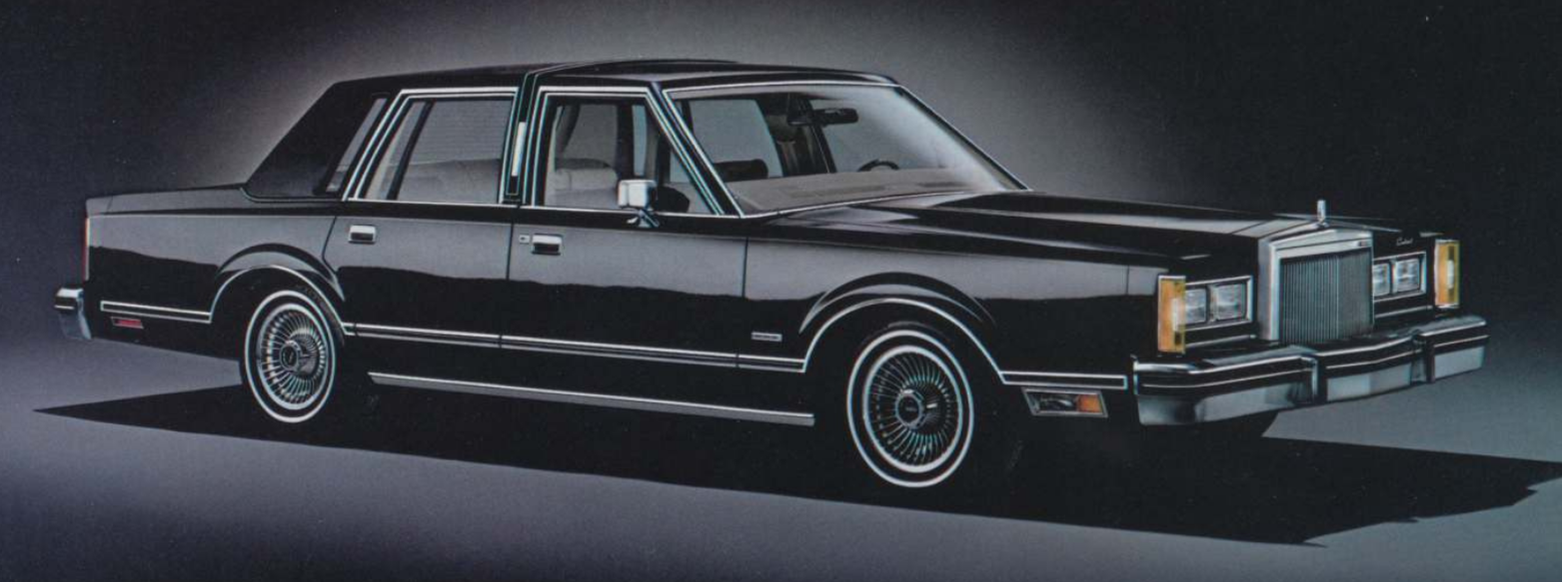
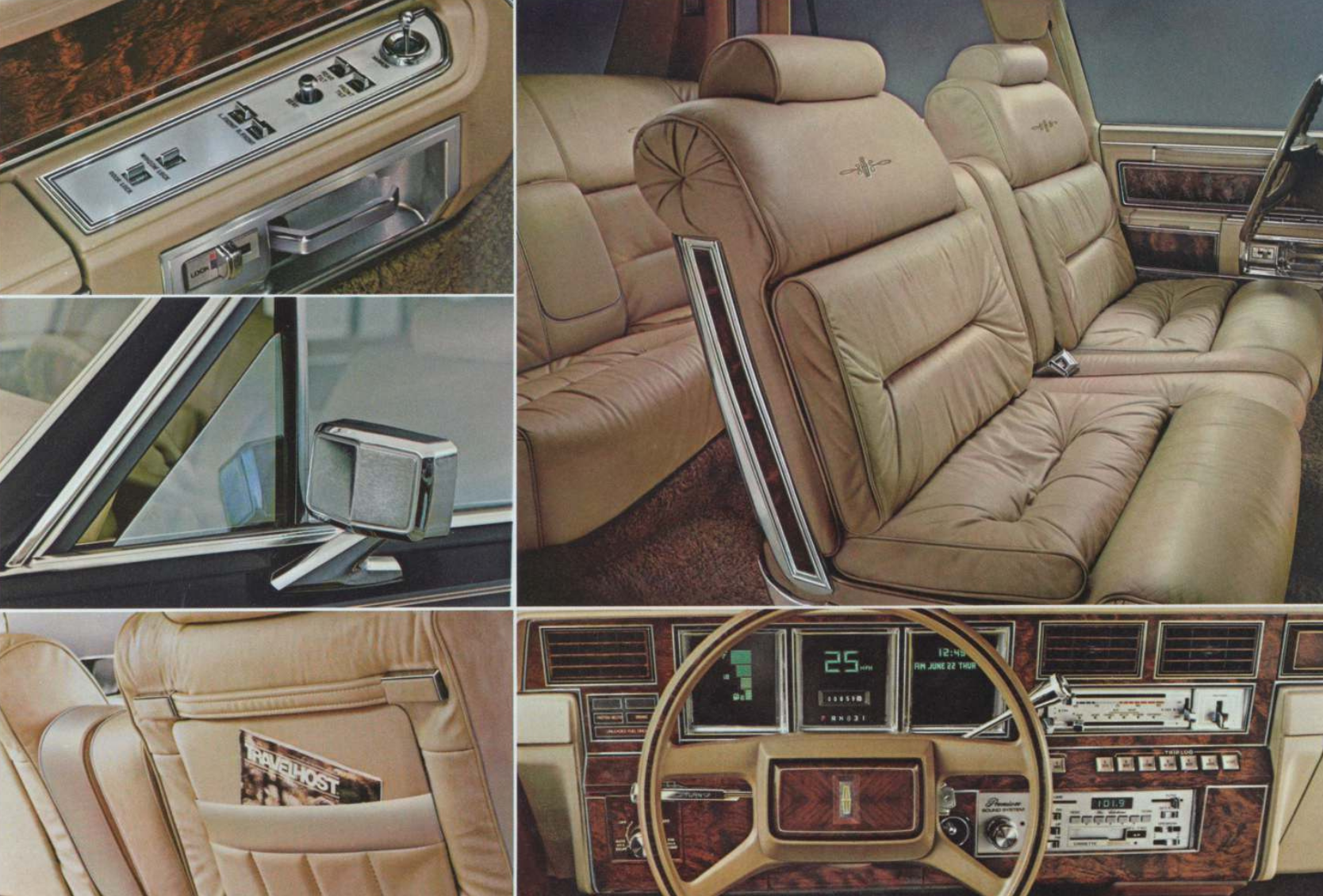
The Lincoln Continental Town Car
The Town Car, the most prestigious Lincoln Continental for 1980. Note such standard exterior features as coach lamps and special Town Car script in rear quarter windows. Options shown on the pictured Town Car are: turbine spoke aluminum wheels, remote control right-hand mirror, premium bodyside moldings, and Illuminated Entry System. As with all Lincoln Continentals, the Town Car provides more overall interior room and more usable luggage space than in either the 1979 Cadillac Fleetwood Brougham or Sedan deVille.
Lincoln Continental has become a standard by which luxury cars are judged. Its interior will show you why. To name but a few of the standard interior features in the Lincoln Continental Town Car: six-way power Twin Comfort Lounge seats in special Town Car Body Cloth with passenger reclining rear seat robe cords; dual floor well lamps, and seat-back map pockets. As an option, you may choose Twin Comfort Lounge seats with seating surfaces upholstered in fine leather.
The newest Lincoln Continental option: the Electronic Instrument Panel with Message Center. Left pod: Electronic Bar Graph Fuel Display. Center: Digital Speedometer, registering in your choice of miles-per-hour or kilometers-per-hour. Right pod: The Electronic Trip Log/Message Center that houses Electronic Digital Clock, monitor/alerts for eleven vehicle functions, and a Trip Log Computer that allows you to determine average distance per gallon, elapsed trip time, distance to destination, estimated time of arrival and much more. Illustrated at right are the power seat and window controls and the optional door lock controls in the armrest, standard power vent window and, standard in the Town Car models, seat-back map pockets.
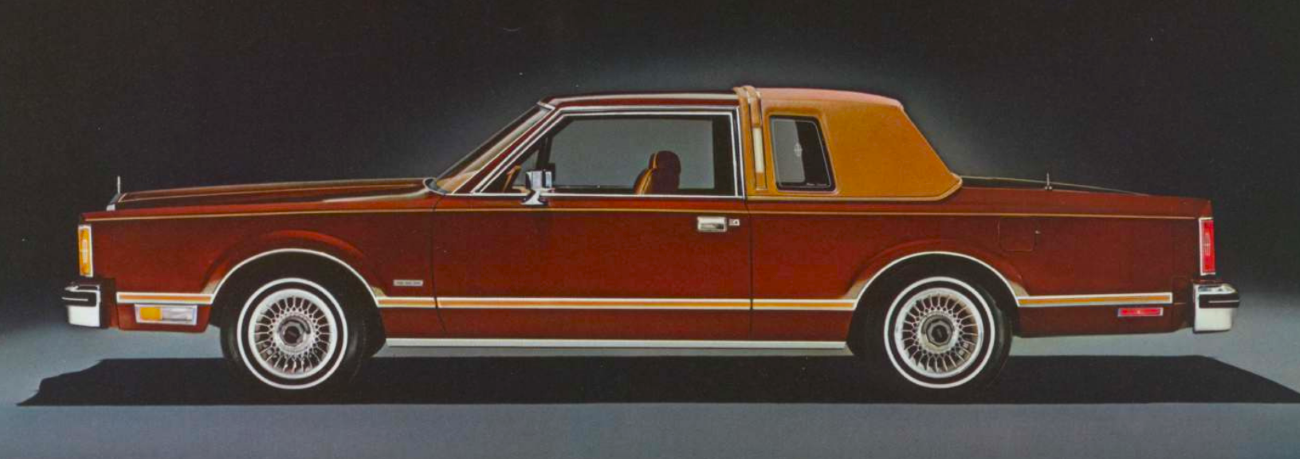
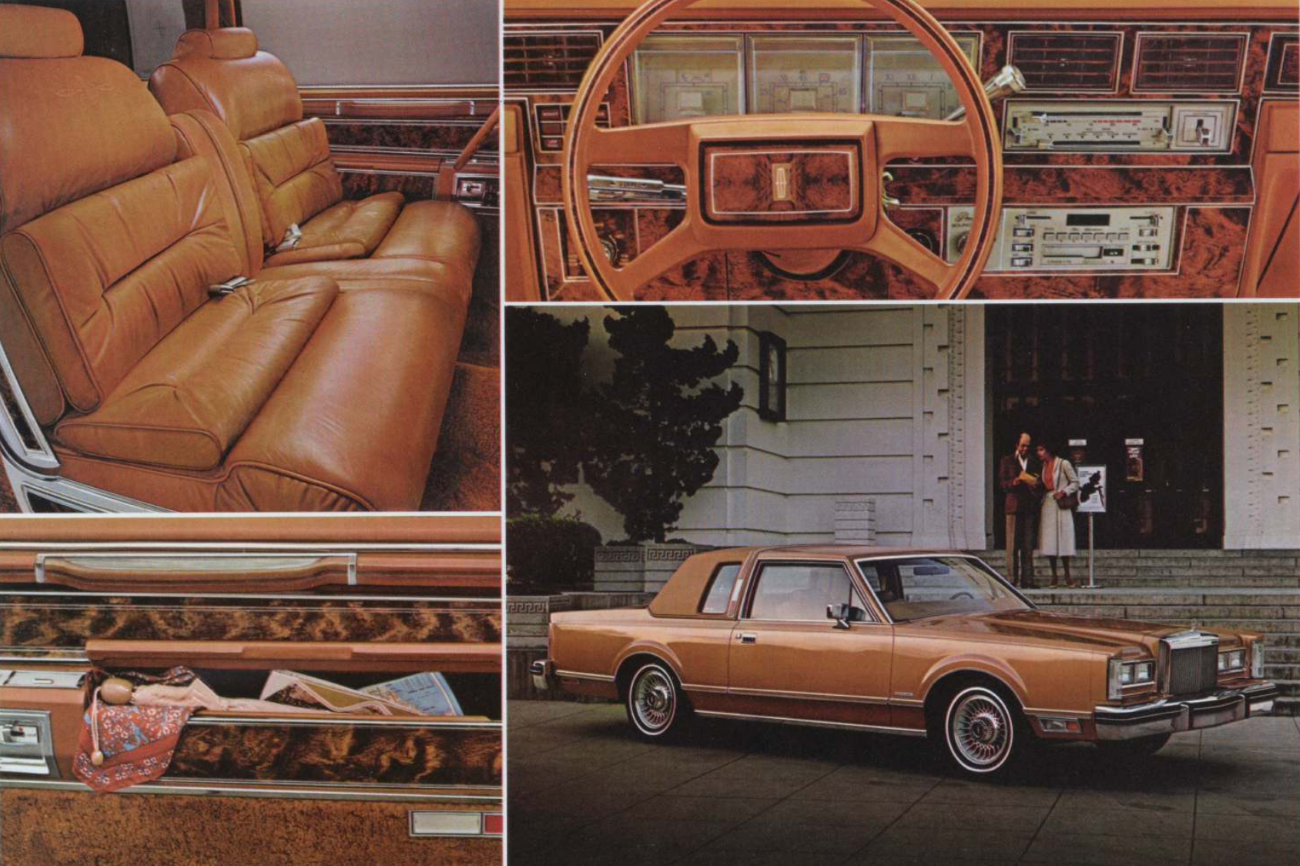
The Lincoln Continental Town Coupé
For 1980, perhaps more than ever before, Lincoln Continental is a “driver’s” car. The Town Coupé, like all Lincoln Continentals, is designed with a new four-bar link rear suspension, a newly engineered front suspension, and low-friction ball joints. If you would appreciate commanding a car that all but anticipates your actions, then a test drive in a new Lincoln Continental is very much in order. Standard features in the Town Coupé are the same as those in the Town Car. Optional features shown on the pictured Town Coupé are: Coach roof, premium bodyside moldings, lacy spoke aluminum wheels, and Illuminated Entry System.
About 800 pounds were eliminated through new designs and advanced engineering, including computer technology. Yet, be assured that legendary Lincoln Continental luxury and comfort have been retained. Near right: the Town Coupé interior with Twin Comfort Lounge seats in optional Caramel color leather seating surfaces. Standard stowage bins in Town Car and Town Coupé front door armrests, with mahogany woodtone door armrest applique.
The Lincoln Continental instrument panel with optional Electronic AM/FM Stereo Search Radio with cassette tape and Dolby® noise reduction feature. New for 1980: steering column mounted stalk controls for headlamp dimmer, horn, turn signals and windshield washer/wiper. As noted earlier, Lincoln interior spaciousness has been retained for 1980. Which means that the 1980 Continentals exceed the 1979 Cadillac deVille in seven out of ten measurements of passenger room. Shown, below right: Lincoln Continental Town Coupé with optional right-hand remote control mirror, Coach roof, lacy spoke aluminum wheels, premium bodyside moldings, and Illuminated Entry System.
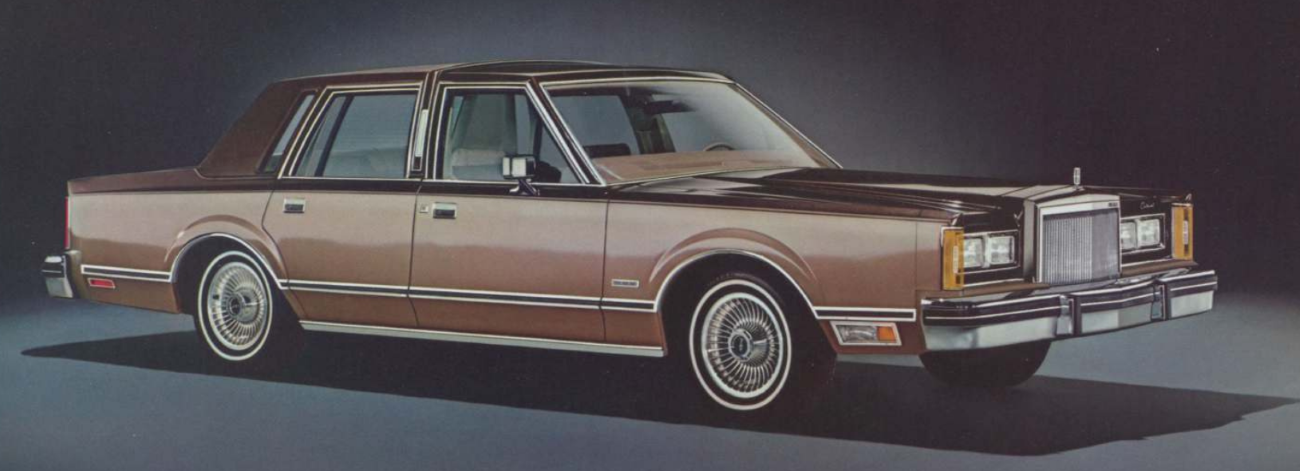
The Lincoln Continental 4-Door Sedan
Lincoln Continental styling continues in its classic configuration, subtly refined for the 1980s. To highlight its crisp, formal lines, Lincoln Continental offers a new Dual-Shade paint option for all 1980 models. The Lincoln Continental 4-doorSedan in Dark Champagne Metallic and Medium Fawn Metallic, one of five color combinations available. Options shown on the pictured 4-door Sedan are: Dual-Shade paint option, turbine spoke aluminum wheels, remote control right-hand mirror, Coach roof, and premium bodyside moldings.
The Flight Bench seat and the rear seat of the Lincoln Continental 4-door Sedan. The color is Medium Vaquera; the material, standard Lincoln Continental Body Cloth; the craftsmanship, superb. And the comfort is singularly Lincoln. Among the many standard features: fold-down front and rear armrests, door pull straps, roof rail assist handles. Chalet cloth molded headliner, retractable coat hooks, and 18-ounce cut-pile floor carpeting.
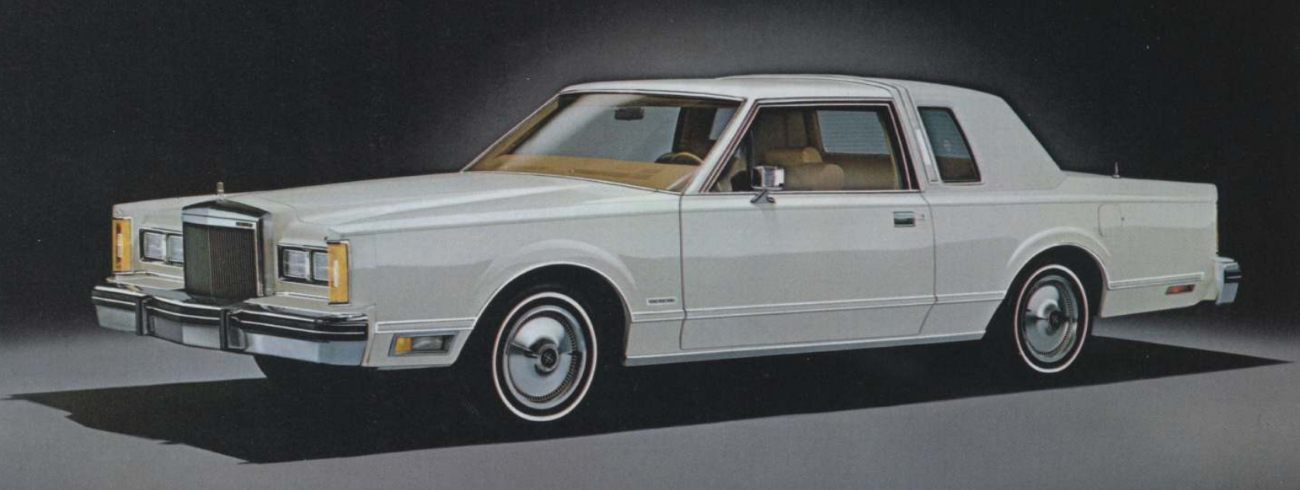
The Lincoln Continental Coupé
Exterior options shown on the Lincoln Continental Coupé at the left: premium bodyside moldings, defroster group. Coach roof, and Illuminated Entry System. Upper right: the new, larger luggage compartment of the 1980 Lincoln Continentals. This deep-well compartment is, in fact, 22.4 cubic feet. Bigger than that of last year’s Lincoln Continental. And 2.8 cubic feet bigger than that of the 1979 Cadillac deVille. Lincoln Continental Coupé interior in Pewter color standard Lincoln Continental Body Cloth.
New Electronic Fuel Injection with electric fuel pump for precise fuel flow. Standard in all Lincoln Continentals with 5.0 literV-8 engine, Electronic Fuel Injection offers improved fuel distribution to each cylinder, and more easily controls fuel loss through evaporation. Electronic Engine Control, standard in all Lincoln Continentals. As you drive, it monitors and controls spark, air and fuel mixture, and exhaust gas recirculation.
1980 Lincoln Continental Standard Features and Equipment
Lincoln Continental Town Car and Town Coupé
Exterior
Integrated coach lamps, Identification script, Luxury wheel covers
Interior
Distinctive seat sew-style, Seat-back robe cords, and map pockets, 18-ounce carpeted door and quarter panel trim, Stowage bins in front door armrests, Instrument panel identification script, Dual floor well lamps, Simulated woodgrain armrest inserts, 9-ounce carpeting in luggage compartment, Padded center pillar with 18-ounce lower carpeting. (Note: Lincoln Continental Town Cars and Town Coupés include all Lincoln Continental standard equipment unless otherwise specified.)
Lincoln Continental 4-Door Sedan and Coupé Standard Equipment
Exterior
Clearcoat paint, Accent stripes (bodyside/hood), Valino grain full vinyl roof*, Rear quarter windows with laminated Continental star (Coupé only), Stand-up hood ornament, Quad rectangular halogen headlamps, Cornering lamps, Left-hand remote control mirror, Deluxe wheel covers (4), Decklid lock cover, Bumper rub strips and front bumper guards, Bright rocker panel and wheel lip moldings, Full-width decklid reflex molding, Electronic Fuel Injection, plaque with standard 5.0 liter V-8 engine
Interior
Lincoln Continental Body Cloth Flight Bench seats with front and rear fold-down center armrests, Deluxe color keyed seat and shoulder belts, 18-ounce cut-pile carpeting in passenger compartment, Lower center pillar carpeting in four-door sedans, Door closing assist straps, Full-length door armrests, Luxury steering wheel, Steering column-mounted stalk controls, Electronic AM/FM Stereo Search radio with four speakers and power antenna, Electronic quartz analog clock, Glove box light, luggage compartment light, ashtray lights, door courtesy lights and rear pillar lights, Dual beam dome/map lamp, Retractable coat hooks, Roof rail assist handles, Scuff plate inserts, Fully lined deep-well luggage compartment with spare tire cover
Functional
5.0L (302 CID) V-8 engine, Electronic Fuel Injection, Electronic Engine Control, Automatic overdrive transmission, White sidewall steel-belted radial tires (Michelin), Automatic Temperature Control air conditioner/heater, Tinted glass, Power steering, Power brakes, front disc/rear drum, Power windows, Power vent windows, Dual note horn, Electronic warning chimes, Mini-spare tire, Coolant Recovery System, Engine temperature gauge 12″, day/night rear view mirror, Fluidic windshield washer system
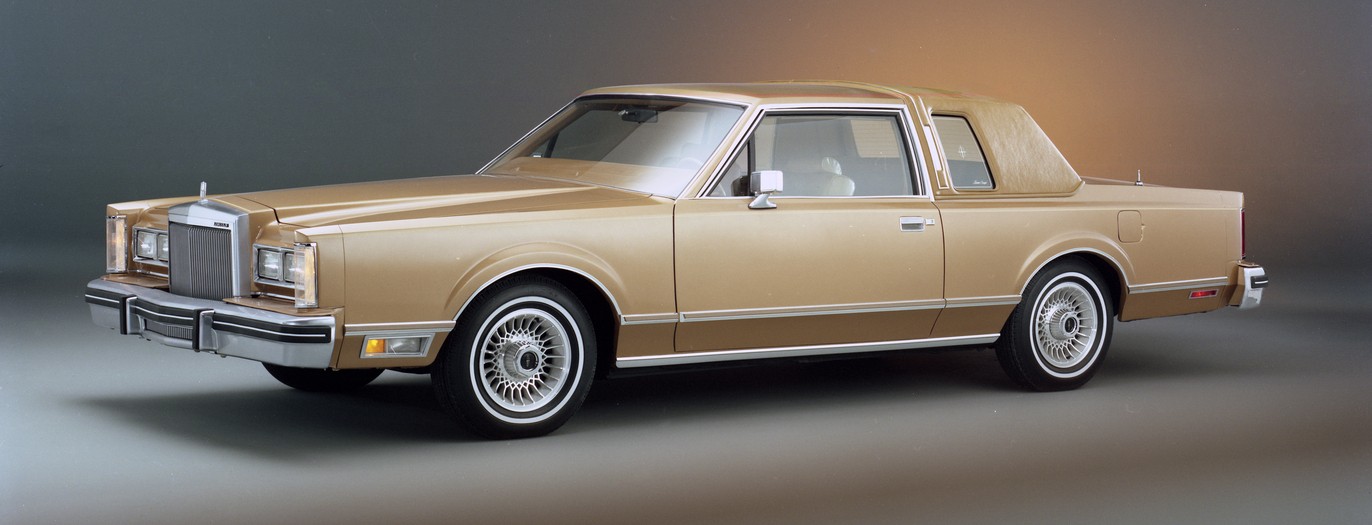
Optional features to further personalize your Lincoln Continental.
A. Electronic Instrument Panel with Message Center, described on page 3. B. Message Center keyboard. Lets you summon digital readout of vital trip/vehicle data. C. Leather-wrapped Luxury steering wheel, and Speed Control, with a Resume feature that lets you automatically accelerate to the same speed set prior to braking. D. Keyless Entry System. A private five-digit code lets you open doors and decklid by using buttons on the driver’s door E. Driver’s reclining seat. F. The Integral Garage Door Opener Control, integrated in driver’s side sun visor with illuminated visor vanity mirrors. G. Power glass moonroof. H. Shown left to right, optional wire wheel cover, lacy spoke aluminum wheel, turbine spoke aluminum wheel, standard Town Car and Town Coupé Luxury wheel cover, and standard Lincoln Continental Deluxe wheel cover A complete listing of optional features follows.
Optional Features Lincoln Continental Sedan and Coupé.
Exterior
Moondust paint ” Dual-Shade paint (five combinations) ” Coach roof with trenched backlite (not available with power moonroof in four-door models) ” Power glass moonroof ” Right-hand remote control mirror ” Owner’s monograms ” Coach lamps ” Turbine spoke aluminum wheels (4) . Lacy spoke aluminum wheels (4) ” Wire wheel covers (4) ” Door edge guards ” Premium bodyside moldings ” Front license plate bracket (standard in all states where required) ” License plate frames (rear only unless front license plate bracket is ordered) ” Wide band white sidewall tires
Interior
Electronic Instrument Panel with Message Center ” Six-way power Twin Comfort Lounge seats with driver and front passenger seat recliner ” Six-way power Twin Comfort Lounge seats with front passenger seat recliner ” Six-way power Flight Bench seat with driver and front passenger seat recliner ” Six-way power Flight Bench seats ” Leather seating surfaces ” Tilt steering wheel ” Leather-wrapped steering wheel (requires Speed Control) ” Speed Control (includes Resume feature) ” Remote control decklid release ” Power door locks ” Integral Garage Door Opener Control (transmitter in left side vanity mirror; requires illuminated visor vanity mirrors. Installation of receiver not included.) ” llluminated visor vanity mirrors ” Radio4Electronic AM/FM Stereo Search with 8-track tape player ” Radio4Electronic AM/FM Stereo Search with Cassette tape player and Dolby® noise reduction system ” Radio-Citizen’s Band 40-channel with tri-band antenna ” Six-speaker Premium Sound System with power amplifier ” Front floor mats ” Rear floor mats
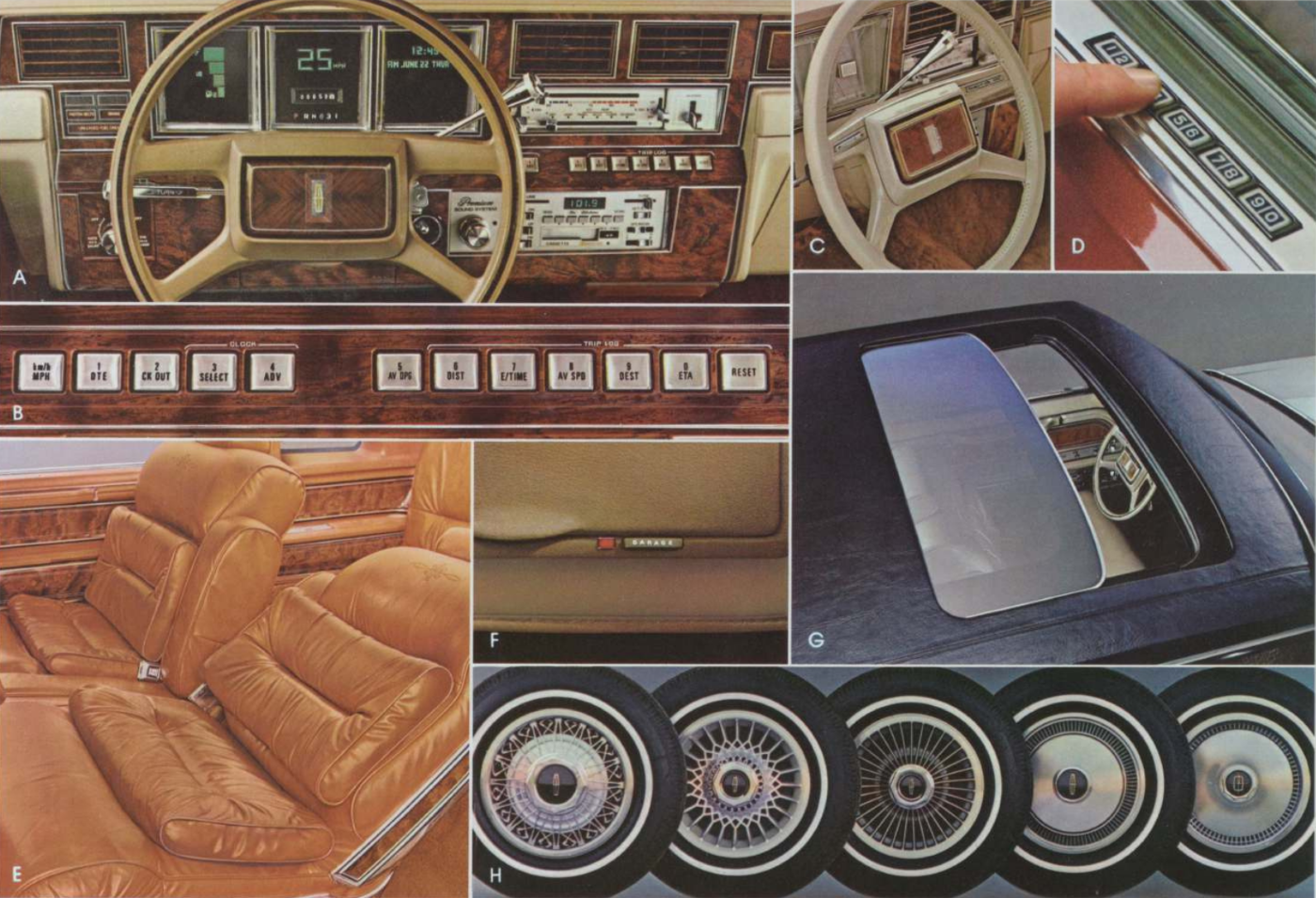
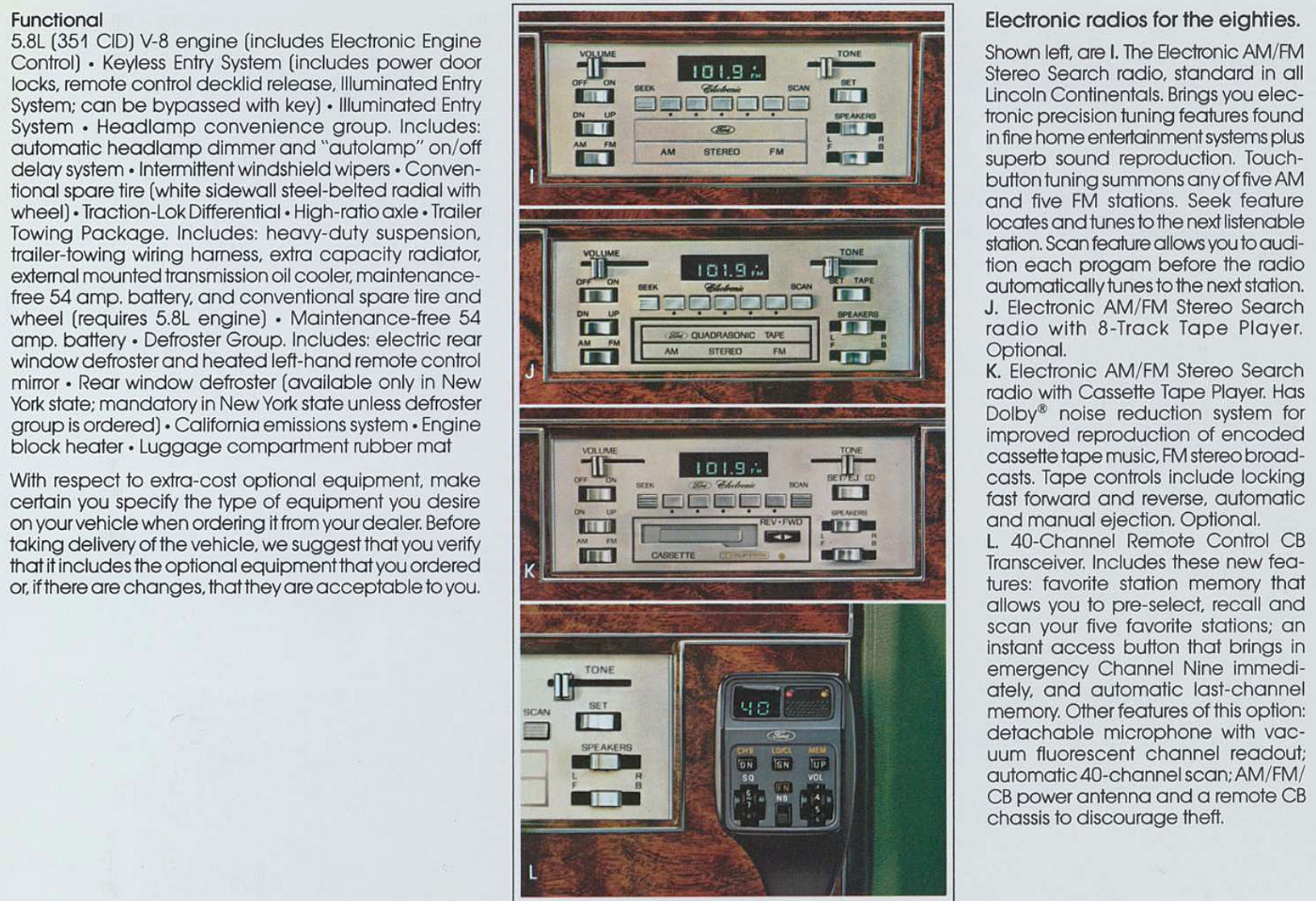
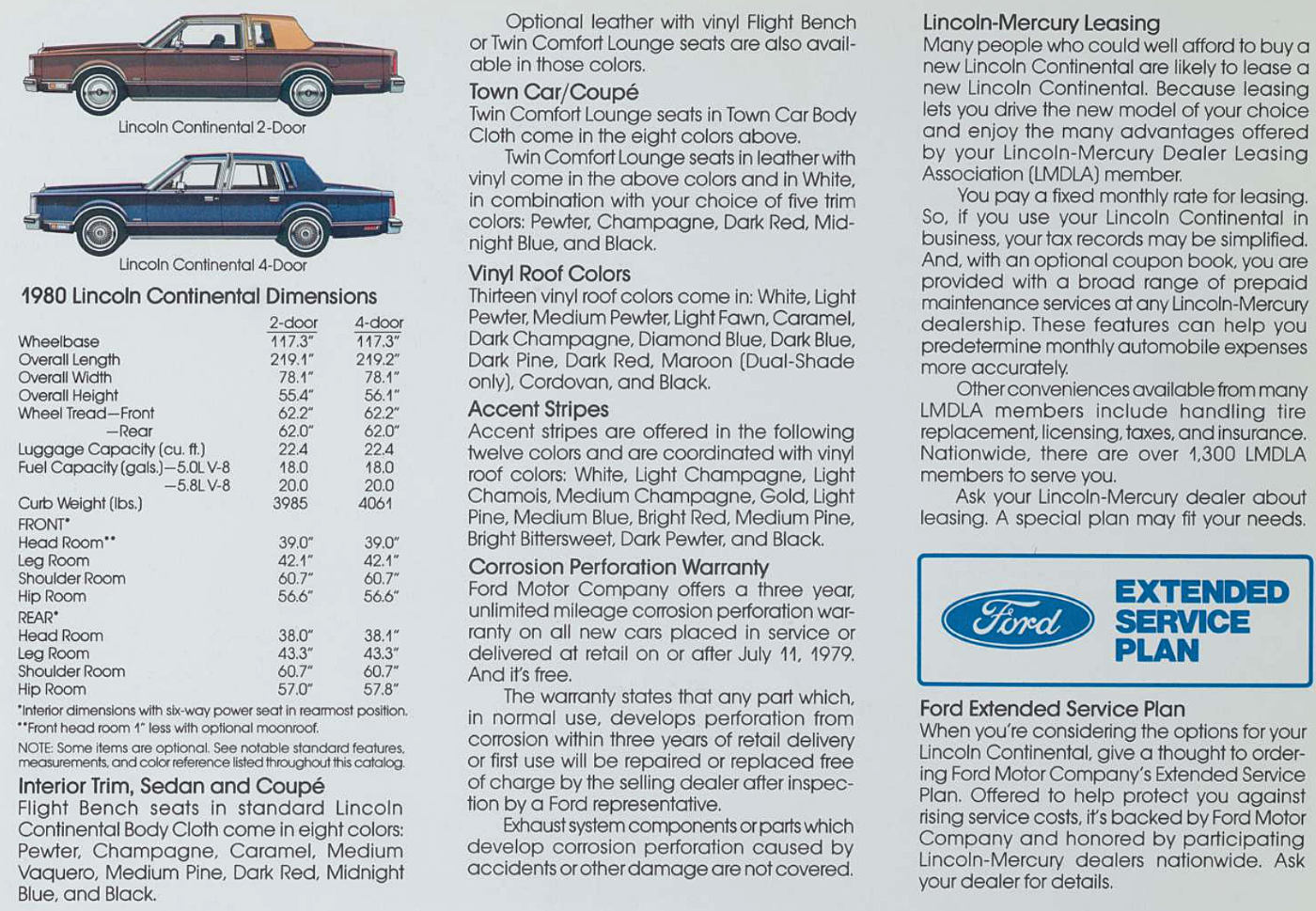
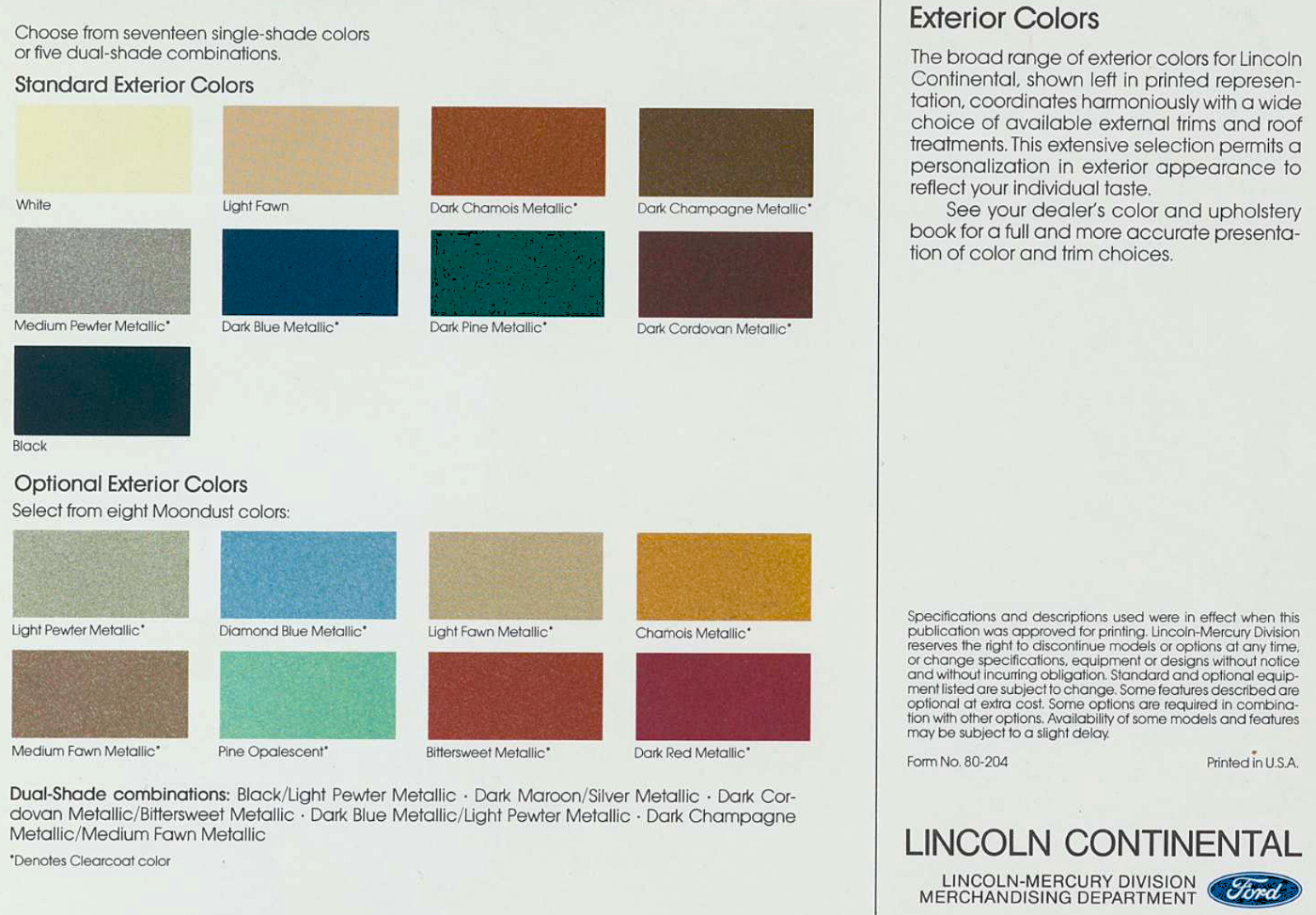
A sophisticated new electronic instrument panel is being pioneered by Ford Motor Company on the 1980 Continental Mark VI and Lincoln Continental. The panel is a three-pod arrangement with an electronic fuel gauge, a digital electronic speedometer and a multiple-function electronic message center. It is standard on the Mark VI and optional on the Lincoln Continental. A second version, consisting of an electronic fuel gauge and speedometer together with an electronic digital clock, is standard in the Mercury Cougar XR-7 Luxury Group and Ford Thunderbird Silver Anniversary and Town Landau and optional on the Cougar XR-7 and Thunderbird, A diagnostic warning-light module is available as a separate option on the XR-7 and Thunderbird and standard in the XR-7 Luxury Group and Thunderbird Silver Anniversary and Town Landau.
“The electronic instrument panel represents the forefront of space-age technology in the automobile, ” said Jerome G. Rivard, chief engineer of Ford’s Electrical and Electronics Division, “and is the most obvious of the electronics which we have been building into the car in recent years. “Up to now, vehicle electronics have been essentially invisible — hidden in little ‘black boxes’ under the hood or dashboard. Now motorists will be able to see for themselves that the wonders of electronics have reached their cars. “More important, the electronic message center component of the panel communicates with drivers for the first time in words, numbers and audible tones,providing them with information never before available in mass-production vehicles. ” As with all other Ford electronic readouts for 1980, the electronic instrument panel will be in bright, bluish-green vacuum fluorescence.
Vacuum-fluorescent displays allow larger number and letter images, are easier to see under adverse conditions and conform to traditional instrument panel lighting better than reddish-orange readouts. The message center screen is in the right pod of the electronic instrument panel in the Mark and Lincoln. Displays are controlled by a row of 12 large numbered and labeled touch buttons arrayed across the lower center of the instrument panel.
Multiple functions of the message center include clock, vehicle monitors and warnings, and programmable trip information. The displays appear in two rows of quarter-inch-high words, abbreviations or numbers, accompanied by audible warnings or computer MbeepM tones. The normal display is a digital clock with time in numbers plus “AM ” or’ “PM, ” the month in abbreviated word, the date in numbers, and the day in abbreviated word. The clock also is displayed when the fourth touch button, “SELECT, is pressed, and is set by use of the adjoining button to the right. The message center automatically monitors and reports to the driver on the condition of 11 vehicle functions at three priority levels — “critical,” “secondary” and “auxiliary,” Critical warnings for brake pressure, alternator, oil pressure or engine temperature appear at four-second intervals, accompanied by a one-second audible tone. Secondary warnings for distance-to-empty, trunk ajar and door-ajar appear for four seconds at 16-second intervals with an initial audible tone. Auxiliary warnings for washer fluid or headlamp-, taillp.mp- or brake lamp-out appear once for four seconds when the condition is detected, and subsequently when the engine is started. In addition, a warnings check-out sequence is provided by triggering the “CK OUT” button.
Trip-log buttons key displays of average distance per gallon, distance traveled, elapsed time, average speed, distance to destination and estimated time of arrival. The last five are programmed by pushing the “RESET” button and entering the estimated or known distance to be traveled. Other buttons control U. S. or metric (miles/kilometers) display, and distance to empty. Electronically, the message center consists of a logic assembly with a microprocessor, two random-access memories, a read-only memory, two peripheral interface adaptors and a custom logic integrated circuit; a display assembly with two latch drivers, a sequencer, display logic, two regulators and two dual operational amplifiers. It can display a total of 36 messages using a vocabulary of 77 words, including some “computerese” for diagnostics. The left and center pods of the electronic instrument panel house, respectively, the fuel gauge and the speedometer.
The electronic fuel gauge graphically indicates the fuel level on a unique bar graph display. The graph is divided into four groups of eight segments each, with each segment indicating about three per cent of capacity. The segment lengths in each group are proportional; i. e. , those in the top quarter are full-length, the next quarter tank three-fourths, the next half-length and the final quarter just one fourth the length of the top quarter. Fuel level is indicated by the segments brightly lit, with the segments above the fuel level at one-twentieth the brightness of the fuel-level segments. The display also includes ” F / 1 “1/2,” ” E ,” and the International Standards Organization (ISO) symbol for fuel, a gas pump and hose. The ISO symbol warning of low fuel flashes once per second, triggered by the fuel level reaching the last bright segment of tank capacity. As a check-out, the ISO symbol also flashes each time the ignition is turned on.
The electronic speedometer features a three-digit, one-and-a-half-’inch high numerical display with smaller letters to indicate whether the readout is in miles or kilometers per hour, as selected by a pushbutton switch. The maximum reading is 85 mph or 137 km/h. The fuel gauge electronics consist of a microprocessor, a display driver and a dual operational amplifier, while the speedometer has a custom logic integrated circuit, decoder driver, regulator and quad operational amplifier.

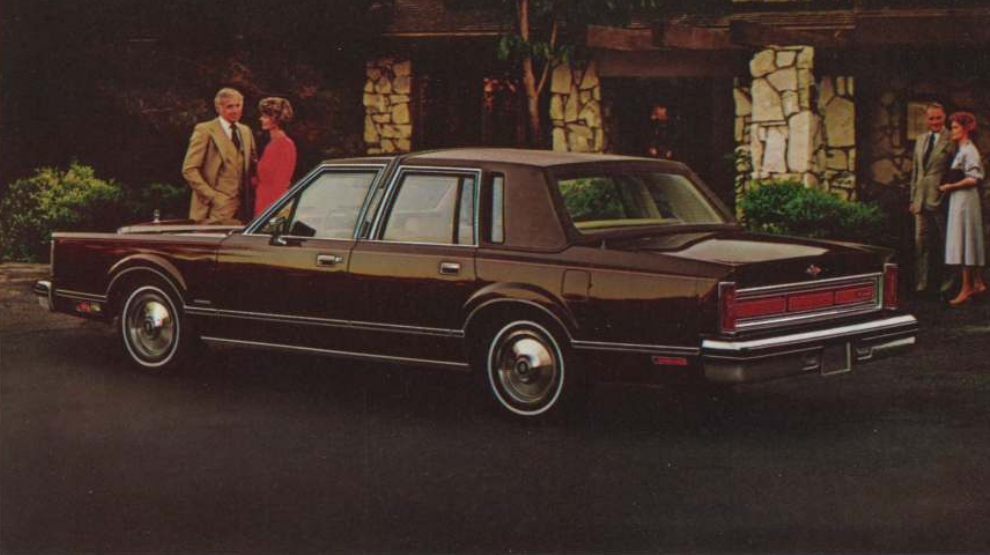
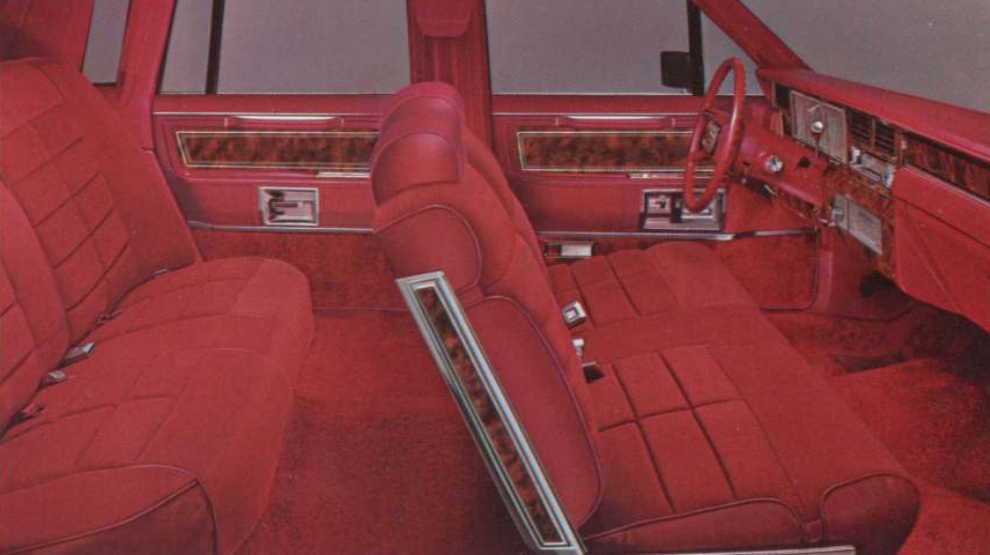
You must be logged in to post a comment.